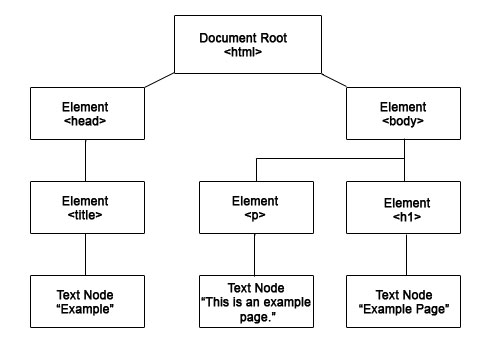A Simple Guide to the Document Object Model (DOM)

The Document Object Model (DOM) is the foundation of all modern web browsers. It’s a tree-like data structure that contains objects representing HTML tags and their attributes, as well as images, style sheets, scripts, and other resources. Learning about the DOM can help you understand how to manipulate elements in your browser or on your website by using JavaScript code.
The following blog post will teach you everything there is to know about the DOM, including DOM Structure; DOM Events; DOM Properties, and DOM Methods. We’ll also go over some common misconceptions about this very important part of web development.
What is the Document Object Model (DOM)?
The Document Object Model is a programming interface for HTML, XML, or other textual content. It allows you to read, navigate, and modify the abstract tree structure of such content. The DOM originally was designed for use with JavaScript but now supports all ECMAScript-compatible languages such as ActionScript 3, C++, C#, VB Script, Python 2.6+, Ruby 1.9+, etc.
DOMs are often used by web browsers and other programs that interact with HTML pages, such as search engine crawlers or tools for editing websites offline. The DOM provides an easy-to-use interface for navigating along the aforementioned hierarchy of nodes in a DOM document.
One of the best-known Document Object Model implementations is in the popular web browser, Firefox, which allows developers to use DOM for converting HTML into a format that can be read by other programs such as search engine crawlers or offline editing tools. Internet Explorer and Microsoft Edge also offer DOM support to their users via ActiveX controls.
How did DOM come into being?
The DOM has been a result of the World Wide Web Consortium (W3C) working jointly with other good Standard Generalized Markup Languages (SGML) to promote interoperability in standards-based web development. DOM Standards have also come from the Document Object Model Working Group which was formed by this same consortium but is no longer active outside of issuing errata for previous releases under public review.
The name “Document Object Model” was chosen because it’s an “object model” in the traditional object oriented design sense: documents are modeled using objects, and the model encompasses not only the structure of a document but also the behavior of a document and the objects of which it is comprised. This DOM enables the objects of which a document consists to be manipulated, both individually and as an aggregate whole (for example with respect to CSS rules for how content should appear on screen). DOML0 was designed specifically as a programming interface that would allow web developers using ECMAScript-based languages such as JavaScript, ActionScript, or Ruby, etc., access to the abstract tree structure in documents containing HTML markup that could then be read and navigated from within those programs by following a specific hierarchy.
DOM Structure
The Document Object Model is an object-oriented API for inspecting and editing a document, which in most cases means an HTML page. DOMs are usually implemented to provide scripting access to the content of documents with markup languages such as XML or HTML.
In the DOM structure, there exist three primary levels of nodes: The Document-level node (or root), Element nodes, and Text nodes.
The Document Level Nodes:
Document-level DOM nodes are the top-most node in a DOM document. Every HTML page has exactly one Document Level DOM node, which represents the entire page. The most important DOM properties of this document node are its URL and title.
The Element Nodes:
Elements can be any visible or invisible tag that is part of an HTML document including tags such as “p” for paragraphs, “script” to find scripts on the webpage, and so on. All elements have several attributes like ID names which are used to identify specific pieces of data within a DOM tree structure), class names (used to assign style sheet classes based on what they contain) or even style attribute values among other things).
Text Nodes:
Text nodes represent all the text found in DOM documents. Text nodes are the lowest level DOM node and they cannot have any children of their own but can contain other DOM elements as well as text content.
DOM Events
DOM Events are a simple and easy way to create interactive elements on DOM based documents. DOM events, unlike standard browser interactions such as scrolling or clicking the mouse, allow web developers an opportunity to respond to things like user input that is not generated by the DOM element itself.
There are several types of DOM event listeners:
Event object listener:
This type of DOM event listener will check for changes in any attributes with its corresponding DOM node. For example, if you have an image tag (<img src=”imageURL” alt=”text”/>), then your function would wait for changes in the src property and listen accordingly when they happen.
Node Listener:
This type of DOM event listener listens for specific child nodes changing within their parent’s DOM node.
DOM Event Listener:
This type of DOM event listener is most commonly used for DOM events that are related to the window, such as onload or even scroll.
DOM Events can have global listeners which will be set in a different document from your DOM page and then they will register themselves with the web browser when you open up this DOM tree. That way if you load another document (e.g., external script) it has access to these DOM events without making modifications to your original codebase outside of adding them in manually. DOM Events also provide an easy solution for callbacks since we don’t need any additional information about where our function should be called – just name and arguments suffice!
TL; DR
– The Document Object Model is an object-oriented API for inspecting and editing a document with markup languages such as XML or HTML
– Document Object Models are usually implemented to provide scripting access to the content of documents with markup languages.
There exist three primary levels of nodes: The Document-level node (or root), Element nodes, and Text nodes.
Document Level DOM Nodes represent the entire page in a DOM document; they have properties like URL and title.
Elements can be any visible or invisible tag that is part of an HTML document including tags such as “p” for paragraphs, “script” to find scripts on the webpage, etc.; all elements have several attributes like ID names which are used to identify specific pieces of data within a DOM tree structure), class names (used to assign style sheet classes based on what they contain) or even style attribute values among other things).
Text Nodes: Text nodes represent all the text found in DOM documents. They are the lowest level DOM node and cannot have any children but can contain other DOM elements as well as text content.
DOM Events allow web developers an opportunity to respond to non-DOM events, like user input that is not generated by the DOM element itself; there exist several types of DOM event listeners such as Event Object Listener, Node Listener, and DOM Event Listener.
DOM Properties
DOM Properties are accessible on DOM nodes to provide detailed information about the DOM node such as what type of DOM element it is, its ID or name, and position within a document.
DOM Properties can be accessed with CSS selectors which allows you to access specific DOM properties by using their corresponding attributes – for example, if we wanted to change the background color of an HTML paragraph tag “p” that has class = ”highlighted”, then our selector would look like this: p.highlighted {background-color:#F00}
There exist four basic types of Document Object Model property values: Boolean (true/false), number, string, and null.
The first three types are most commonly used in JavaScript programming because they correspond directly to the three DOM node types: Document, Element, and Text.
Null values are commonly used when inserting DOM nodes into a document in order to represent their absence or lack of data within them.
DOM Methods
DOM Methods are used to output DOM data in the form of HTML.
There exist several DOM methods that can be accessed on DOM nodes and they allow you to manipulate what is rendered onto a web page, for example changing text colors or background color of an element within the DOM tree structure so it interacts with other DOM elements more easily!
The most commonly used DOM methods are getElementById(), innerHTML() (which allows developers to change an entire HTML document dynamically), outerHTML() which changes just parts of the original XML/XHTML document without having to remove existing tags first; these two functions work particularly well when using JavaScript because they don’t break any markup rules.
The getElementsByTagName(tagname) function allows DOM developers to access tags by name from the DOM tree structure and can be used with JavaScript. The DOM methods are, however, not cross-browser compatible so they should always be tested in a browser for optimal interaction.
DOM and JavaScript Interaction
Document Object Models and JavaScript can be used in tandem with DOM events to create interactive web pages. DOM methods are not limited to altering the DOM tree structure of a webpage, they can also interact with user input like mouse clicks or keyboard strokes among other things – this is called event handling where DOM methods use events (like “onClick”) for interaction that would otherwise have been impossible using just HTML alone!
JavaScript has access to all Document Object Model nodes within an HTML document so it’s possible for developers to alter text content on a page via scripting without ever changing the original markup language code. This makes scripts faster because only changes need to be made instead of adding entire new tags as well as more flexible due to its ability for dynamic manipulation. It should be noted though that DOM is not supported by all browsers, so it’s important to test JavaScript code before using it on a live website.
Conclusion
The Document Object Model is an interface that was created by the World Wide Web Consortium (W3C). This model allows for a developer to access and modify parts of documents on any given web page. It can be used with JavaScript in order to interact with HTML elements, CSS style sheets, and other aspects of a website’s functionality. If you need help implementing this tool or have questions about it at all, feel free to contact us! We offer top-notch services from experienced professionals who are ready to work hard for your business or organization.




